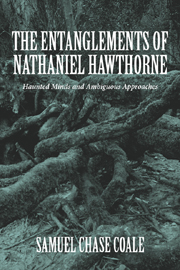Book contents
- Frontmatter
- Contents
- Acknowledgments
- List of Abbreviations
- Introduction: Entanglements
- 1 The Legacy of The Scarlet Letter: Hawthorne in Contemporary Culture
- 2 Hawthorne as Nineteenth-Century Morbid Genius
- 3 Biographical and Critical Veils in the Nineteenth Century
- 4 Biographical Visions of the Twentieth Century
- 5 Entangled Polarities: The New Criticism
- 6 Doubting Dualisms: The Strategies of Hawthorne's Romance
- 7 Ideological Contexts: Deconstruction, Feminism, the New Historicism, Race, and Entanglement
- Works Cited
- Index
3 - Biographical and Critical Veils in the Nineteenth Century
Published online by Cambridge University Press: 12 September 2012
- Frontmatter
- Contents
- Acknowledgments
- List of Abbreviations
- Introduction: Entanglements
- 1 The Legacy of The Scarlet Letter: Hawthorne in Contemporary Culture
- 2 Hawthorne as Nineteenth-Century Morbid Genius
- 3 Biographical and Critical Veils in the Nineteenth Century
- 4 Biographical Visions of the Twentieth Century
- 5 Entangled Polarities: The New Criticism
- 6 Doubting Dualisms: The Strategies of Hawthorne's Romance
- 7 Ideological Contexts: Deconstruction, Feminism, the New Historicism, Race, and Entanglement
- Works Cited
- Index
Summary
The nineteenth century declared that Hawthorne was a genius, as if that resolved everything about him and his work, and scattered impressions this way and that about his vision of solitude and isolation, his morbid mind and his solitary ways, his fixation on guilt and sin, sorrow and sympathy, all in an atmosphere of proclaiming the birth of a genuine American literature to counteract the British hold on American culture and fiction. But the man himself managed to evade all would-be critics and scattershot analysts, presenting himself to the world in his prefaces as a pale Romantic fellow, haunted in haunted rooms, and troubled by his fascination with allegory as if it were small recompense for his inability to grapple with the real world that lay around him, opaque, dense, and indecipherable.
Yet another dualism or polarity haunts every Hawthorne biography: how was one to relate the “morbidity” of his vision to the elegant gentility of his style? Was the latter used to disguise the former? Was the vision itself so dark that Hawthorne could only approach it instead of descending into it? How could such a life be lived with this nearly schizophrenic division between the dark romancer who buried himself in solitude in his study and the practical man who worked to obtain political appointments? Biographers would shift back and forth from one to the other, from periods in which the dark romancer took over the center of the tale to the reinstatement of the practical man of letters.
- Type
- Chapter
- Information
- The Entanglements of Nathaniel HawthorneHaunted Minds and Ambiguous Approaches, pp. 43 - 65Publisher: Boydell & BrewerPrint publication year: 2011

